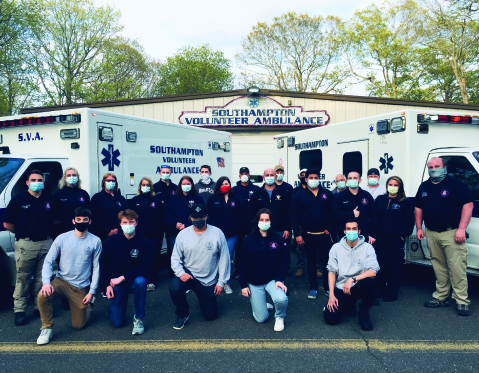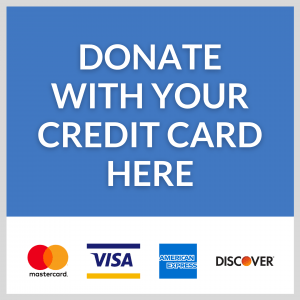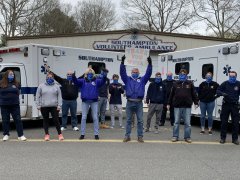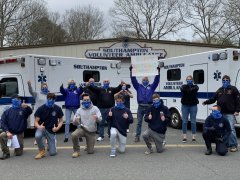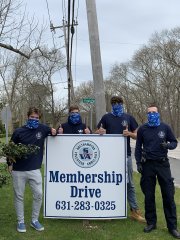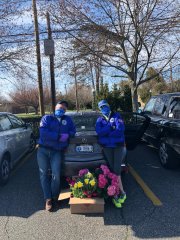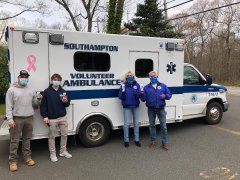EMS Week
What would I do if …
Do you ever wonder, “What would I do if …”
Someone’s choking — could I deliver the Heimlich maneuver?
A mouth’s swelling from a bee sting — could I jab the epipen?
A dude drops like a rock with a stopped heart — could I give CPR? And where’s the closest AED, anyway?
A friend’s flailing in the pool — could I safely land them, clear their lungs?
That lady seems disoriented, her words are garbled — could I assess her with the Cincinnati stroke test?
That party boy’s had too much. Wait, those pupils are tiny — could I give him nasal Narcan?
There’s blood, lots of it — can I stop that?
A car crashes — would I see past my inconvenience, the shock and awe?
Would I recognize severe blunt trauma if it reached out and hit a child over the head?
Could I, would I, be the one to take action when action is needed? Be the one who helps others feel safe? Be calm in the face of the storm?
Safety consciousness is about being present. And like most “presence,” it’s a gift we give to ourselves before we can share it with others.
This brings me to my friend Enzo Cerillo, an ordinary guy, commercial fisherman, glad to share a striped bass. Enzo has a remarkable ability to land a whopper of a crisis into the safety net.
One day, on his way home from the gym, he witnessed a severe trauma incident, and his calm 911 call delivered medivac when minutes mattered most.
More recently, he awoke to a crash and a clatter, and sprang from his bed to see what was the matter. On the street and armed with two belts, he found Ed Downes, who, on his way to work, had stopped and recognized that a tourniquet was needed. A tourniquet and two leather belts earned that patient the one vital minute they needed to preserve life, with an outlook for recovery.
Enzo happens to be a driver with the Southampton Volunteer Ambulance, and Ed is an EMT, and former president at Sag Harbor Ambulance.
Ed says what amazed him most was how calm everyone was, from the bystanders who magically assembled themselves into handling small tasks, to the EMS crew who attended the patient and activated the full resources of the emergency medical system.
Enzo’s take: “You just have to focus on the patient, and everything else falls into perspective, like grace under pressure.”
Yes, they’re skilled volunteers who prepare for readiness. And, like you, they’re ordinary people, going about their daily lives. That’s where emergencies happen: in the course of our daily lives.
So, would I, could I, if I had to? EMS has taught me it’s easier to navigate a crisis if you’ve planned for it. And someone else’s crisis doesn’t have to be mine. In an emergency, minutes can make the difference between life and death.
So, follow that impulse to notice what feels wrong, register someone’s need, and get or bring help. Call your local ambulance and take a class in basic first aid, hands-only CPR, administering nasal Narcan, or Stop the Bleed. Learn the signs of a stroke, hyperthermia, hypothermia and drug overdose.
Take measures to prevent emergencies in the first place: fasten seat belts, don’t drink and drive, don’t speed or text while driving. Monitor alcohol intake of self and friends, calling a taxi as needed. Watch when children are near the pool. Keep your eyes open.
National EMS Week is May 15 to 21. With Memorial Day’s kickoff fast approaching, we’re expecting a busy summer.
So let’s look out for one another.
Adele Kristiansson lives in Water Mill. She is an EMT and a driver with the Southampton Volunteer Ambulance.
- Publication: East Hampton Press
- Published on: May 16, 2022
- Click here for article link in Southampton Press
What If You Dialed 911 and No One Showed Up?
National EMS Week is May 16-22. This time last year, we at The Southampton Volunteer Ambulance felt like civilians caught behind enemy lines. The Mission Impossible tape had burned behind us, and the Fed had “disavowed any knowledge of our participation, should anything go wrong” — like, God forbid, we catch COVID in the line of duty. No disability, unemployment, financial aid, health benefits, medical priority. No preferential COVID testing: nada.
Low call volume was a barometer of how scared the community was: in March, April, May, it plummeted to a creepy, this-town’s-too-quiet lull. Traumatic injuries and MVA’s (car crashes) declined, as people huddled at home, or feared the hospital more than their presenting complaint.
Our personal call volume revealed how nakedly at-risk we EMS volunteers felt. I was one of the members who recused from running calls due to personal health risk, or family/employer risk concerns. So, a relative few bore the greater burden, some running close to 400 calls.
In May, I eased back into service, deciding to drive rather than tech, to eliminate my patient contact in the back of the rig. We treated every call as potential COVID, and adjusted our personal risk threshold case by case. Often, we learned boundaries the hard way, realizing post facto the risks presented by our own kindness.
It’s hard to override years of training and the impulse to intervene as another suffers. On my first call back, we responded to a code, an unwitnessed drowning. Of course, I ran across the field to help wheel the stretcher; naturally, I stabilized our patient’s head while our medic
1
Suctioned and we progressed CPR. Only later, did I recognize I had placed myself in an enclosed space during the only aerosolized protocol the CDC hadn’t eliminated? A dawning fear gripped my stomach: could I be infected by a newly deceased patient?
By summer, call volume had risen dramatically - sky-rocketing housing and rental prices reflected the exodus of the city-dwellers. Our patients had to adjust to moving protocols too, and some of them pushed back. Again, I learned the hard way, I couldn’t permit family members to ride up front, a courtesy we normally extend. Some couldn’t see past their own concern to appreciate how their proximity posed a potential hazard to me.
By fall, “The New Yorker” posted a great headline: “It’s Labor Day, and Nobody’s is Leaving the Hamptons. No, Sherlock. No
Tumbleweed Tuesday. Public School admissions spiked, and 2020 was our busiest year ever, with 1,075 calls.
Phil Cammann, our former Suffolk REMSCO President said, “COVID will find and expose our stress cracks.” COVID showed me how resilient - and fragile - our EMS infrastructure is. Foremost, how the line of “First” response shifts so quickly - including nurses, doctors, Uber drivers, check-out clerks, delivery people, teachers, and long-term care- providers.... as well as EMS, FD, and PD.
Secondly, how the Big Ask keeps coming. In January, after 10 months of limited PPE supplies, revolving-door protocols, chronic worry, the rise of Zoom and Herculean effort to balance conduct of business with member security ... we got to the front of the vaccine line. No sooner had we mobilized and up-trained recused members than we were asked to learn vaccination protocols and serve 8-hour stand-by shifts at community vaccine sites. While people were delighted to get their shots, did they
2
recognize the many sacrifices, made by so many unseen neighbors, that made their privilege possible?
Today, I reflect upon the domino effect of the Colonial Pipeline cyber-attack. Panic lines at gas stations, resource insecurity, the outcry for stronger, more protected infrastructure. I see a hostage-taking of America quite similar to our experience with COVID. I see anew, how the many are dependent upon the few. How personal security depends upon collective vigilance. How we cannot rest while others carry the load.
As our Federal government seeks to strengthen national infrastructure, I wonder: are we considering fully the human factor in our national infrastructure? Do we recognize our dependence upon volunteer service? Do we appreciate the rising personal cost of being a volunteer? What are we each doing to preserve the volunteer infrastructure of our community?
Serving my community is a guiding principle I have cultivated all my life. Service is a foundational value of American democracy and a gateway to our cultural experience. Don’t you feel safer knowing someone will help if you get hurt or in trouble? What if you dialed 911 and no one showed up?
Yet volunteer EMS is becoming a luxury many of us struggle to afford. Income disparity squeezing out the working class means people need 2-3 jobs to survive: less time for running rigs 24/7. In the land of the 4,000 - 20,000 sq. ft McMansion, it’s not “profitable” to build housing affordable to the young people we need to rejuvenate our ranks and provide primary medical services.
Despite these hardships, SVA members served even more last year: despite job loss, economic hardship, illness, home-schooling and additional EMS demands. We added 18 new members to our ranks,
3
appointed a District Supervisor to help us manage the long-view, and continued plans for a new building to replace the tin can we built in 1970 when we ran calls in a retrofitted hearse.
Volunteer EMS is hybridizing. In other states, you can get whacked with a $2,000-$4,000 bill for emergency transport. We plan hard to keep our services free of charge and to secure universal access to emergency care.
Waving at us in the July 4th parade is all well and good, but if we are to survive, we need global support at all community levels: planning, funding, housing, social services. Help however you can. Visit us at www.townems.org . Metaphorically speaking, don’t simply draft the ambulance as we make our way through heavy traffic, yield, and help pave the way.
What If You Dialed 911 And No One Showed Up? - 27 East
Adele Kristiansson lives in Water Mill and is an EMT/Driver with the Southampton Volunteer Ambulance
Search
SVA Members login
Sample gallery images
IMG_0277.JPEG
IMG_0302.JPEG
IMG_0305.JPEG
IMG_02.jpeg
IMG_01.jpeg


